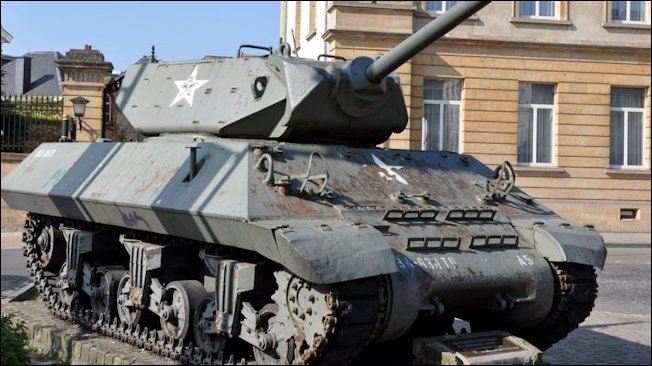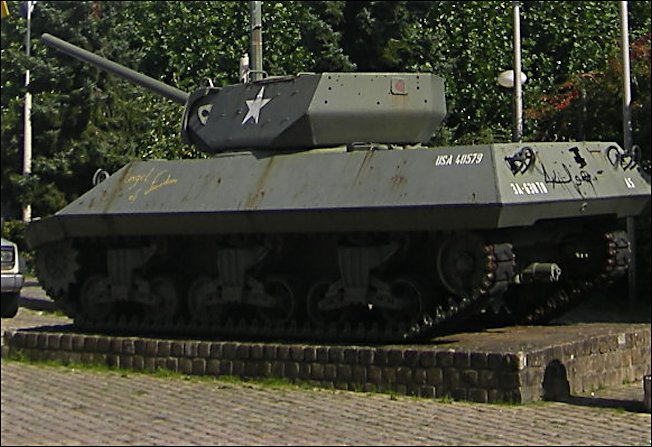Arlon British M10c Achilles
This Surviving British Achilles Tank Destroyer in Arlon, Luxemburg took part in the 1944 WW2 Battle of the Bulge in the Belgium and Luxemburg Ardennes. It has been restored and can be seen in the town square called Place Léopold 1, Arlon, Belgium.

British M10c Achilles Tank Destroyer in Arlon, Luxemburg
This British 17pdr M10c Achilles Tank Destroyer was placed in the town square in Arlon to celebrate the liberation of Arlon 10th September 1944 by American troops. After the war the Belgium Army purchased 17pdr M10 Achilles Tank Destroyers from the British Army. It was was a British variant of the American M10 Wolverine tank destroyer armed with the more powerful British Ordnance QF 17 pounder anti-tank gun in place of the standard American 3 inch (76.2 mm) Gun M7. It was made to look like an American M10 Wolverine to keep the American Tourists happy. The 17 pounder Gun Muzzle brake was removed and it was painted in American Army colours and markings.
It may have been knocked out from a direct hit on the engine compartment because there is a plain metal cover instead of its normal armoured covers on top of the engine deck. The side of the tank is marked 'Angel of Freedom'. The open turret has also been sealed off to visitors with a metal cover.
M10 Tank Destroyers fight Panther tanks
On Christmas Eve, 1944, during the Battle of the Bulge, American troops in the village of Manhay in the Belgium Ardennes were under a night attack by Panzergrenaders and Panther tanks belonging to the 2nd SS Panzerkorps.
American Lt Col Richardson had just crawled out of the burning Sherman tank at the main crossroads. He hitched a ride on a jeep to the outskirts of the town where he encountered two M10 Wolverine tank destroyers.
In the distance he saw a dim low silhouette coming across a field to the north-east. It moved so fast that he was sure it was a German Panther tank. He told the first M10 tank destroyer commander to fire at anything that moves. He then rushed through the snow towards the second tank destroyer, which was innocently heading in the direction of the Panther.

Arlon British M10c Achilles Tank Destroyer. Its rear turret counterweight has been removed and so has the muzzle brake on the gun.
On seeing him the M10 Wolverine commander slowly backed up. Richardson pointed to the field. 'A Panther will be here any minute. Don't try to get in from the front.' There was a blast to his left. He turned just-in-time to see the American tank destroyer fire a round into the side of the approaching Panther. The German tank, shrouded in smoke, suddenly flamed up.
Then suddenly there was a deeper blast. Richardson knew this came from a Panther tanks 75mm gun. As the tank destroyer backed up frantically there was a second German 75 mm shot. The American M10, with its thin armour, flew apart with a tremendous detonation.
The first American tank destroyer now fired, as the enemy came in within range. The shell hit the front plates of the Panther tank. It's front sloping armour gave it the equivalent armoured protection of 140mm. Much stronger than a Tiger tank. Sparks flew as the shell bounced off the Panther that continued to move forward. Its turret turned and the long 75 mm gun belched smoke. The first American M 10 Wolverine tank destroyer tipped over smoking
M10 ambushes Tiger
'Tanks were on fire up the road. The road was a gentle rise and an infantry guy came running toward us. He said there's a halftrack coming. So we thought, "Halftrack, boy oh boy! Where is she? Big Andy was my driver. He eased the tank back off of the road.'
'Ted Duskin was my gunner. He swings the gun out and lays it up the road. And through this smoky haze that the fire is making, here comes this German, but it ain't no halftrack. It's one of the big German Tiger tanks. And I just remember thinking, 'God, this is gonna hurt.' Ted shot immediately as that bulk came through the haze and he must have hit the turret; there was a big shower of sparks. They were heavily armored in the front and they were only really vulnerable in the rear. 'About a second after we fired, he fired. A big lick of flame came out of the muzzle of the gun and it hit our tank,'
'It seemed to hit it down low in the carriage and made a hell of a sound. And suddenly, the German began to move backwards into the smoke. How lucky can you be? We quickly took a look at our tank and one of the bogey wheels appeared to be almost severed, He hit us down low. It glanced off fortunately for us. And with the track still intact, Andy could ease her back. We eased her back down the slope and that German didn't come after us. But talk about being scared. They had the firepower. They could penetrate us. We couldn't penetrate them until we got a larger gun.'
'After we backed down around a curve in the road, there was a rock wall and there was enough room for us to get in there. Ahead of us, against the same rock wall, was a M10 tank destroyer. They had light armor, but they had a bigger gun than we had so they could knock out a German tank which we couldn't: So as soon as 'we got behind the destroyer, I ran out and told the destroyer's commander what was probably going to be coming down the road, so he could get a good shot at it.'
'The German doesn't know the tank destroyer is here. First thing you know, we could hear little click-clicks. That's about all the noise their tracks made: click-click. They were real quiet. We would make lots of noise and we'd give ourselves away. 'He's coming down!' Then bang. The M10 knocks him out with a shot to his side.'
M10 Wolverines of the 823rd
M10s of the 823rd TD Battalion had stopped leading elements of Kampfgruppe Peiper near Neufmoulin short of Werbomont. Combat engineers had blown the only bridge over the Lienne Creek capable of supporting tanks near Habiemont,right in the face of Peiper's tanks. As a result, the Germans could only send half-tracks over a wooden bridge nearby.
A string of anti-tank mines was pulled across the road by one combat engineer leading from the wooden bridge. A mine disabled the first half-track that crossed over further delayed the Germans. This allowed time for elements of the 119th Infantry, 30th Division, supported by the 823rd TD Battalion to get into position to ambush the German half-tracks when they tried to advance in the dark towards Werbomont. Five half-tracks of the 10th Company 2nd SS Panzergrenadier Regiment, including two SdKfz 251/9 armed with a 7.5cm howitzer, were knocked out or captured
So, when the 82nd Airborne Division and the supporting 703rd TD Battalion arrived at Werbomont, there weren't any German units to attack. In fact, the 504th Parachute Infantry Regiment pressed a SdKfz 251/9 captured intact in the ambush into service - manned by a driver, a BAR man and two members of the anti-tank gun company to operate the 7.5cm howitzer. This came in handy when the 504th had to attack Cheneux defended by the anti-aircraft half-tracks (with plenty of 2cm automatic AA cannons). Two M36 from the 703rd TD battalion assigned to support the attack did not join the action initially because of some confusion.
The captured half-track provided valuable support, knocking out at least one FLAK wagon and a couple of machine gun nests. When the two M36 did go forward, their 90mm proved very effective ... helping the paratroopers pinned down by murderous 2cm cannon fire to move forward and capture Cheneux.
Battle of the Bulge books

